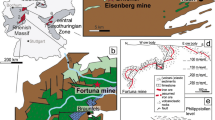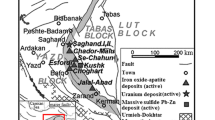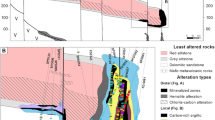Abstract
The Somea iron deposit is located ~ 22 km northwest of Ahar, NW Iran. The lenticular iron ores are formed as open space fillings within the pinch and swell structures of a curved fault in a highly brecciated zone within the host andesitic to dacitic rocks. Fe mineralization comprises magnetite and pyrite in the hypogene zone and hematite, limonite, and goethite in the supergene zone. According to the geochemical analysis results, the average grade of Fe ore is about 53 wt%. Magnetite ore is massive and lenticular in shape. Pyrite is formed as veins/veinlets in the crushed zones and fractures within the magnetite ore, following the continued tectonic movements along the fault. Goethite displays spongy and box-work, as well as botryoidal and colloform textures. Spongy and box-work textures indicate the very high acidity of the leaching fluids, which may be resulted from the oxidation of pyrite veins/veinlets. Banded and colloform textures are produced by colloidal precipitation from fluids. Hematite has formed either due to the alteration of magnetite or by dehydration of goethite at the oxidized zone. The very high Fe/Mn ratio of ore samples may indicate the hypogene genesis of the ore-bearing fluids, which were most likely originated from the neighboring Sheyvardagh granitic–granodioritic intrusion. Sulfur isotopic composition of the pyrite samples reveals a magmatic origin for the ore-bearing fluid and its sulfur content, which further advocates the hydrothermal genesis of the ore body. The δ34S values of the pyrite separates are ranging between − 1.4 and − 0.69‰ (V-CDT).







Similar content being viewed by others
References
Agha Nabaty E (2004) Geology of Iran. Geological survey and mineral exploration organization of Iran, Tehran, p 586 (in Persian)
Alavi M (1991) Sedimentary and structural characteristics of the paleo-Tethys remnants in northeastern Iran. Geol Soc Am Bull 103(8):983–992. https://doi.org/10.1130/0016-7606(1991)103<0983:SASCOT>2.3.CO;2
Alavi M (1994) Tectonics of the Zagros orogenic belt of Iran: new data and interpretations. Tectonophysics 229(3-4):211–238. https://doi.org/10.1016/0040-1951(94)90030-2
Alavi M (2004) Regional stratigraphy of the Zagros fold-thrust belt of Iran and its proforeland evolution. Am J Sci 304(1):1–20. https://doi.org/10.2475/ajs.304.1.1
Bajwah ZU, Secombe PK, Offler R (1987) Trace element distribution, Co:Ni ratios and genesis of the big Cadia iron–copper deposit, New South Wales, Australia. Mineral Depos 22:292–300
Berberian F, Berberian M (1981) Tectono-plutonic episodes in Iran. In: Gupta HK, Delany FM (eds) Zagros, Hindu Kush, Himalaya: geodynamic evolution. Geodyn ser, Am Geophys Union 3:5–32. https://doi.org/10.1029/GD003p0005
Bigham JM, Nordstrom DK (2000) Iron and aluminum hydroxyl-sulfates from acid sulfate waters. In: Alpers CN, Jambor JL, Nordstrom DK (eds) Sulfate minerals: crystallography, geochemistry and environmental significance. Rev Mineral Geochem 40:351–403. https://doi.org/10.2138/rmg.2000.40.7
Bigham JM, Schwertmann U, Traina SJ, Winland RL, Wolf M (1996) Schwertmannite and the chemical modeling of iron in acid sulfate waters. Geochim Cosmochim Acta 60(12):2111–2121. https://doi.org/10.1016/0016-7037(96)00091-9
Burnham CW, Ohmoto H (1980) Late-stage processes of felsic magmatism. Min Geol Spec Issue 8:1–11
Clark AH, Arancibia ON (1995) The occurrence, paragenesis and implications of magnetite-rich alteration-mineralization in calc-alkaline porphyry copper deposits. In: Clark AH (ed) Giant ore deposits, II: Controls on the scale of orogenic magmatic-hydrothermal mineralization, Proceedings of the Second Giant Ore Deposits Workshop, April 25–27, 1995. Queens University, Kingston, pp 511–581
Einaudi MT, Hedenquist JW, Inan EE (2003) Sulfidation state of fluids in active and extinct hydrothermal systems: transitions from porphyry to epithermal environments. In: Simmons SF, Graham I (eds) Volcanic, geothermal and ore-forming fluids: rulers and witnesses of processes within the earth. Soc Econ Geol Spec Pub 10:285–313
Faure G (1986) Principles of isotope geology, 2nd edn. John Wiley, New York 589 p
Ghorbani M (2013) The economic geology of Iran: mineral deposits and natural resources. Springer, Dordrecht, 581 p. https://doi.org/10.1007/978-94-007-5625-0
Ghorbani MR, Bezenjani RN (2011) Slab partial melts from the metasomatizing agent to adakite, Tafresh Eocene volcanic rocks, Iran. Island Arc 20(2):188–202. https://doi.org/10.1111/j.1440-1738.2010.00757.x
Hemley JJ, Hunt JP (1992) Hydrothermal ore-forming processes in the light of studies in rock-buffered systems: II. Some general geologic applications. Econ Geol 87(1):23–43. https://doi.org/10.2113/gsecongeo.87.1.23
Henley RW, Truesdell AH, Barton PB, Whitney JA (1984) Fluid-mineral equilibria in hydrothermal systems. Rev Econ Geol 1:267
Holland HD, Malinin SD (1979) The solubility and occurrence of none-ore minerals. In: Barnes HL (ed) Geochemistry of hydrothermal ore deposits, 2nd edn. Wiley Interscience, New York, pp 461–508
Jahangiri A (2007) Post-collisional Miocene adakitic volcanism in NW Iran: geochemical and geodynamic implications. J Asian Earth Sci 30(3-4):433–447. https://doi.org/10.1016/j.jseaes.2006.11.008
Javidi Moghadam M, Heidarian Shahri MR, Karimpour MH (2010) Geology, mineralization, geochemistry and megnetometric studies on iron mineralization in Kalateh Shahin region, Khorasan Razavi province. J Econ Geol 1:77–96 (in Persian with an English abstract)
John DA, Garside LJ, Wallache AR (1999) Magmatic and tectonic setting of late Cenozoic epithermal gold-silver deposits in northern Nevada, with an emphasis on the Pah Rah and Virginia ranges and the northern Nevada rift. Geol Soc Nevada Spec Pub 29:65–158
Landtwing MR, Pettke T, Halter WE, Heinrich CA, Redmond PR, Einaudi MT, Kunze K (2005) Copper deposition during quartz dissolution by cooling magmatic-hydrothermal fluids: the Bingham porphyry. Earth Planet Sc Lett 235(1-2):229–243. https://doi.org/10.1016/j.epsl.2005.02.046
Maynard JB (1983) Geochemistry of sedimentary ore deposits. Springer-Verlag, 305 p. https://doi.org/10.1007/978-1-4613-9493-8
Mehrpartou M, Amini Fazl A, Radfar J (1992) Geologic map of Varzeghan. Geological Survey of Iran, scale 1:100 000, 1 sheet
Mehrpartou M, Nazeri NK (1999) Geologic map of Kaleybar. Geological Survey of Iran, scale 1:100 000, 1 sheet
Meinert LD (1995) Magmas, fluids and ore deposits. Mineral Assoc Can, Short Course Ser 23:401–418
Mollaei H, Yaghubpur AM, Sharifiyan Attar R (2009) Geology and geochemistry of skarn deposits in the northern part of Ahar batholith, East Azarbaijan, NW Iran. Iran J Earth Sci 1:15–34 (in Persian with an English abstract)
Mollai H, Sharma R, Pe-Piper G (2009) Copper mineralization around the Ahar batholith, north of Ahar (NW Iran): evidence for fluid evolution and the origin of the skarn ore deposit. Ore Geol Rev 35(3-4):401–414. https://doi.org/10.1016/j.oregeorev.2009.02.005
Nabavy H (1976) An introduction to the geology of Iran. Geological Survey of Iran, Tehran, p 109 (in Persian)
Najafzadeh Tehrani P, Calagari AA, Abedini A, Mazlumi AR (2013) The geological, mineralogical, alteration features, and rare earth elements (REEs) geochemistry of Neyzar iron deposit, southwest of Mashhad, northeast of Iran. Iran J Crystall Mineral 21:229–242 (in Persian with an English abstract)
Nicholson K (1992) Constraining mineralogical-geochemical signatures of manganese oxides: Gudies to metallogenesis. Econ Geol 87(5):1253–1264. https://doi.org/10.2113/gsecongeo.87.5.1253
Ohmoto H (1972) Systematics of sulfur and carbon isotopes in hydrothermal ore deposits. Econ Geol 67(5):551–579. https://doi.org/10.2113/gsecongeo.67.5.551
Ohmoto H, Rye RO (1979) Isotopes of sulfur and carbon. In: Barnes HL (ed) Geochemistry of Hydrothermal Ore Deposits, 2nd edn. John Wiley and Sons, New York, pp 509–567
Paterson JT, Cloos M (2005) Grasberg porphyry Cu-Au deposit, Papua, Indonesia: 2. Pervasive hydrothermal alteration. In: Porter TM (ed) Super Porphyry Copper and Gold Deposits. A global Perspective, vol 2. PGC Publishing, Adelaide, pp 331–355
Rajabzadeh MA, Rasti S (2011) Mineralization study on Dehbid magnetite deposit, Fars, using mineralogical and geochemical data. J Econ Geol 2:217–230 (article in Persian with an abstract in English)
Toth JR (1980) Deposition of submarine crusts rich in manganese and iron. Geol Soc Am Bull 91(1):44–54. https://doi.org/10.1130/0016-7606(1980)91<44:DOSCRI>2.0.CO;2
Ulrich T, Heinrich CA (2002) Geology and alteration geochemistry of the porphyry Cu-Au deposit at Bajo de la Alumbrera, Argentina. Econ Geol 97(8):1865–1888. https://doi.org/10.2113/gsecongeo.97.8.1865
Whitney DL, Evans BW (2010) Abbreviations for names of rock-forming minerals. Am Mineral 95(1):185–187. https://doi.org/10.2138/am.2010.3371
Wood SA (1998) Calculation of activity-activity and log fO2-pH diagrams. In: Richards JP, Larson PB (eds) Techniques in hydrothermal ore deposits geology, Rev Econ Geol, vol 10, pp 81–96
Zarabi Rad R (2008) Geology, mineralogy and genesis of Ileh iron prospect, southwest of Taibad (east Iran). MSc thesis, University of Tabriz, Tabriz, Iran, 81 p
Acknowledgements
Authors would like to express their thanks and appreciation to the authorities in the Research Bureau of the University of Tabriz for their financial support. Our appreciation is further expressed to the anonymous reviewers for making critical comments and valuable suggestions on this manuscript.
Funding
This study was financially supported by the Deputy Dean of the Research Bureau of Tabriz University through the grant no. 90213.
Author information
Authors and Affiliations
Corresponding author
Rights and permissions
About this article
Cite this article
Simmonds, V., Calagari, A.A. & Sadeghi, Z. Mineralogy, geochemistry, and genesis of the volcanic-hosted hydrothermal iron ore deposit in Somea, NW Iran. Arab J Geosci 11, 82 (2018). https://doi.org/10.1007/s12517-018-3418-5
Received:
Accepted:
Published:
DOI: https://doi.org/10.1007/s12517-018-3418-5




